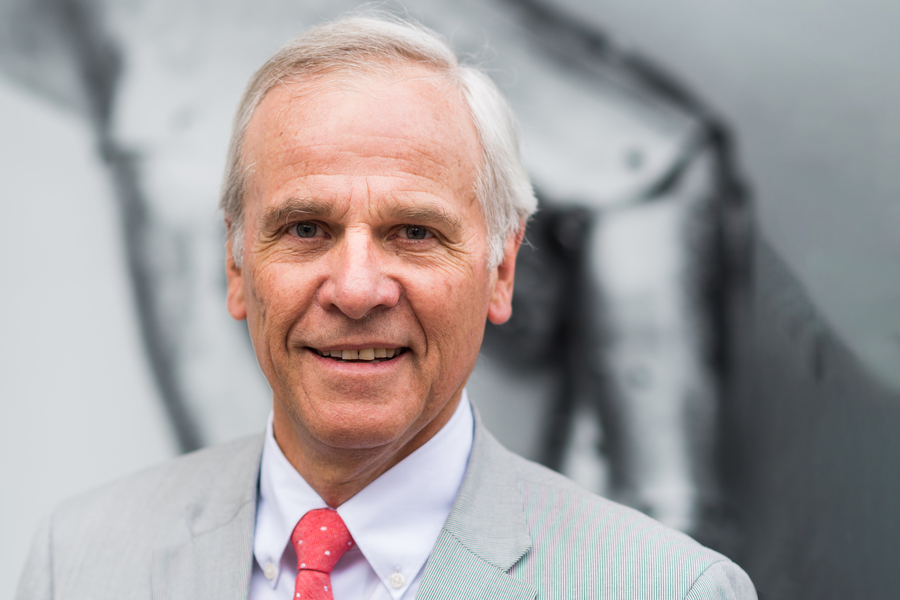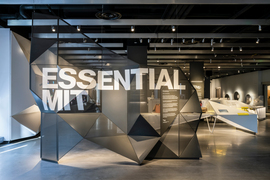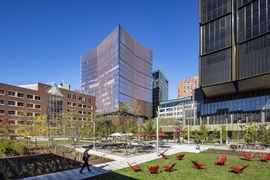John Durant, who led a transformation of the MIT Museum that culminated in the opening of the new museum in Kendall Square last fall, has announced he will be stepping down as director on Dec. 31. He will continue to serve as an adjunct professor in MIT’s Program on Science, Technology, and Society.
“I am grateful for John’s visionary leadership and commitment over his 18-year tenure to make MIT’s artifacts of innovation accessible to the public,” Provost Cynthia Barnhart wrote today in a letter of the MIT faculty. “He leaves a museum poised for the future, where open discourse and discovery will thrive for years to come.”
The new museum, in its custom-built, 56,000-square-foot-space at the new gateway to MIT’s campus, serves as the most visible monument to Durant’s success as director. But since arriving at MIT in 2005, he has spearheaded a number of other highly acclaimed initiatives that have helped the museum reach new heights in its ability to communicate MIT’s innovations to the world.
One of the most prominent is the Cambridge Science Festival, an annual celebration of science and technology that transcends the museum’s walls to span the entire town of Cambridge for several days each year. Durant started the festival in 2007 to engage members of the local community who might not otherwise wander through the museum’s doors.
“I’ve always felt that research and innovation are just far too important to be left to scientists and engineers,” says Durant, who is the Mark R. Epstein Director of the MIT Museum. “Science and technology have such pervasive impacts, and they’re so pervasively interesting to so many nonscientists, that it’s always been important to me to make sure the rest of the public is in a position to deal effectively with them in their own lives.”
When Durant first took over as director, the museum occupied a small space on the second floor of two buildings that were also used by several other MIT groups.
“It was intriguing in its way, but not quite commensurate with what MIT is,” Durant recalls. “When I came in, I tried to up the game of the MIT Museum to make it in keeping with the rest of the Institute — to make it something MIT could be proud of.”
By 2007, Durant was able to expand the museum’s footprint to include the street-level space below, where it could display eye-catching artifacts in its windows and more easily invite foot traffic.
In order to raise awareness of the museum on campus, Durant launched a series of short talks where MIT faculty could come in and speak about whatever subject they were passionate about. Each talk could only be 15 minutes, but the audience engagement would often last much longer.
Durant launched the Cambridge Science Festival soon after, a first-of-its-kind event that has allowed for experimentation in new forms of public outreach. One effort that stands out to Durant is the time the festival organized “The Human Genome Trail.” This trail turned the stretch of road between the Kendall Square and Harvard Square T stops into a model of the human genome, complete with 23 pairs of lampposts to serve as markers of the chromosomes. A trail guide walked visitors along the genome, where every step represented thousands of DNA base pairs.
“It was one slightly crazy way of trying to make the inaccessible accessible,” Durant says. “Cambridge has been a center of genomic research, and we wanted to make that more apparent to people.”
Under Durant’s leadership, the museum has also launched a number of innovative programs and exhibitions, including a virtual reality exhibition that leveraged the cutting edge of the technology in 2017 to bring visitors face to face with the human side of war through 360-degree imaging and recordings.
Durant has also brought the museum to a position of prominence in the MIT community by hosting events, classes, and showcasing collections from MIT’s rich history for the first time.
“One of our roles is to be a kind of meeting ground,” Durant says. “We can attract MIT students and faculty, business leaders and entrepreneurs, members of the general public, tourists from across the country and around the world — we’re a meeting ground for all of these groups.”
The new museum offers space to further many of Durant’s aspirations.
“In short, [the new museum] does three things: It helps the world find MIT, it helps the world understand MIT, and, I hope and believe, it will inspire the world to love MIT,” said former MIT president L. Rafael Reif at the new museum's opening ceremony. “As long as I have been here, I have seen people come out of the T station and look around, asking, ‘Where is MIT?’ Now they will know, right away, and a huge part of this exciting new portal to our campus is our new museum. For a lot of people, what we do at MIT is pretty hard to understand. The MIT Museum offers a gentle introduction … a small sampling of a much larger menu.”
One of the first spaces visitors encounter when they walk into the new museum is an amphitheater dubbed The Exchange, that features stadium seating and a large media wall to facilitate conversations and presentations. The new museum has roughly three times more space for face-to-face, hands-on activities than the old museum.
“We are sitting in an extraordinary new museum because of John’s vision,” says MIT Museum Director of Collections Deborah Douglas. “[Opening the new museum] has been a mix of exhilaration and exhaustion, but through it all John has been relentlessly optimistic and bold, even in the face of some pretty stiff headwinds. Raising money and overseeing the building of a new museum in the middle of a global pandemic were remarkable feats.”
“John’s a visionary leader who has lifted the museum onto the national and international stage,” says MIT Professor and Associate Provost Philip S. Khoury. “The new museum opened last year to rave reviews locally and nationally. How fortunate MIT has been to have John Durant as a member of our community these past 18 years.”
Durant says he’s stayed at MIT for so long because it’s continued to offer stimulating challenges worth solving. Among those challenges is experimenting with the museum’s unique position on campus. Unlike the defined roles of labs and classrooms, with their more easily measurable outputs, he sees the museum’s function as more ambiguous.
“It’s much harder to define what exactly it is and who it’s for,” Durant says. “That might seem like a problem, but I actually think it’s an advantage. We have one foot in the Institute and one foot in the broader community. Maybe that sounds uncomfortable, but boy, the things you can do with that.”
The museum’s mission of engaging with the public around innovations is integral to MIT’s broader mission, according to Durant.
“For MIT to be complete, it needs to think through — with the community — the larger social dimensions of the research it does,” Durant says. “Look at debates about things like AI, where you see an explosively rapid development that has all kinds of implications for everyday life. I see us as having a really important role to be the people who think specifically about how you engage larger communities in these conversations.”









